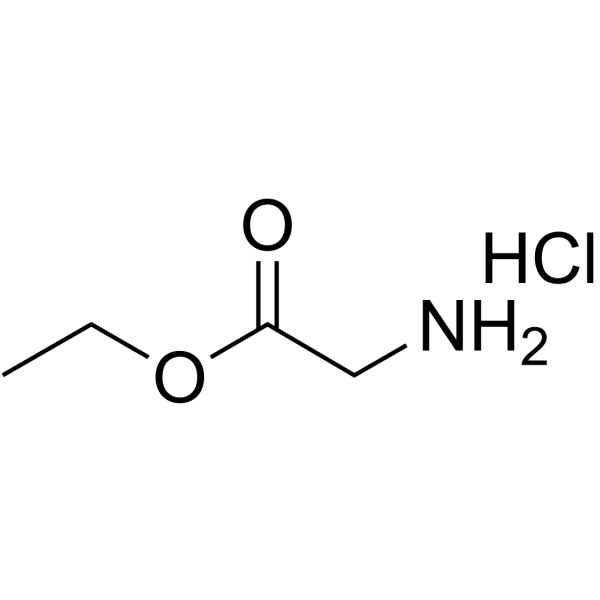Glycine ethyl ester hydrochloride

Glycine ethyl ester hydrochloride structure
|
Common Name | Glycine ethyl ester hydrochloride | ||
|---|---|---|---|---|
| CAS Number | 623-33-6 | Molecular Weight | 154.595 | |
| Density | 1 g/cm3 | Boiling Point | 109.5ºC at 760 mmHg | |
| Molecular Formula | C4H10ClNO2 | Melting Point | 145-146 °C(lit.) | |
| MSDS | Chinese USA | Flash Point | N/A | |
| Symbol |

GHS05 |
Signal Word | Danger | |
|
Anti-rheumatic agent auranofin induced apoptosis in chronic myeloid leukemia cells resistant to imatinib through both Bcr/Abl-dependent and -independent mechanisms.
Oncotarget 5(19) , 9118-32, (2014) Resistance to Imatinib mesylate (IM) is an emerging problem for patients with chronic myelogenous leukemia (CML). T315I mutation in the Bcr-Abl is the predominant mechanism of the acquired resistance to IM and second generation tyrosine kinase inhibitors (TKI... |
|
|
Catalase therapy corrects oxidative stress-induced pathophysiology in incipient diabetic retinopathy.
Invest. Ophthalmol. Vis. Sci. 56 , 3095-102, (2015) Preclinical studies have highlighted retinal oxidative stress in the pathogenesis of diabetic retinopathy. We evaluated whether a treatment designed to enhance cellular catalase reduces oxidative stress in retinal cells cultured in high glucose and in diabeti... |
|
|
Inherited BCL10 deficiency impairs hematopoietic and nonhematopoietic immunity.
J. Clin. Invest. 124(12) , 5239-48, (2014) Heterotrimers composed of B cell CLL/lymphoma 10 (BCL10), mucosa-associated lymphoid tissue lymphoma translocation protein 1 (MALT1), and caspase recruitment domain-containing (CARD) family adaptors play a role in NF-κB activation and have been shown to be in... |
|
|
FTY720 enhances TRAIL-mediated apoptosis by up-regulating DR5 and down-regulating Mcl-1 in cancer cells.
Oncotarget 6 , 11614-26, (2015) FTY720, Fingolimod, is a functional antagonist to the sphingosine-1-phosphate (S1P) receptor and an inhibitor of sphingosine kinase 1. Here, we showed that a combination of FTY720 and TRAIL induced apoptosis in human renal, breast, and colon carcinoma cells. ... |
|
|
Activation of the PI3K/Akt/mTOR and MAPK Signaling Pathways in Response to Acute Solar-Simulated Light Exposure of Human Skin.
Cancer Prev. Res. (Phila.) 8 , 720-8, (2015) The incidence of skin cancer is higher than all other cancers and continues to increase, with an average annual cost over $8 billion in the United States. As a result, identifying molecular pathway alterations that occur with UV exposure to strategize more ef... |
|
|
Astroglial NMDA receptors inhibit expression of Kir4.1 channels in glutamate-overexposed astrocytes in vitro and in the brain of rats with acute liver failure.
Neurochem. Int. 88 , 20-5, (2015) Astroglial inward rectifying Kir4.1 potassium channels are fundamental for the maintenance of ion and water homeostasis in the central nervous system (CNS). Down-regulation of Kir4.1 expression is observed in CNS disorders associated with excessive extracellu... |
|
|
Effect of sodium zirconium cyclosilicate on potassium lowering for 28 days among outpatients with hyperkalemia: the HARMONIZE randomized clinical trial.
JAMA 312(21) , 2223-33, (2014) Hyperkalemia is a common electrolyte abnormality that may be difficult to manage because of a lack of effective therapies. Sodium zirconium cyclosilicate is a nonabsorbed cation exchanger that selectively binds potassium in the intestine.To evaluate the effic... |
|
|
Mass spectrometry footprinting reveals the structural rearrangements of cyanobacterial orange carotenoid protein upon light activation.
Biochim. Biophys. Acta 1837(12) , 1955-63, (2015) The orange carotenoid protein (OCP), a member of the family of blue light photoactive proteins, is required for efficient photoprotection in many cyanobacteria. Photoexcitation of the carotenoid in the OCP results in structural changes within the chromophore ... |
|
|
PERC rule to exclude the diagnosis of pulmonary embolism in emergency low-risk patients: study protocol for the PROPER randomized controlled study.
Trials 16 , 537, (2015) The diagnosis of Pulmonary Embolism (PE) in the emergency department (ED) is crucial. As emergency physicians fear missing this potential life-threatening condition, PE tends to be over-investigated, exposing patients to unnecessary risks and uncertain benefi... |
|
|
Novel micelles from graft polyphosphazenes as potential anti-cancer drug delivery systems: drug encapsulation and in vitro evaluation.
Int. J. Pharm. 373(1-2) , 133-40, (2009) In this study, a new class of amphiphilic methoxy-poly(ethylene glycol) grafted polyphosphazene with glycine ethyl ester side groups (PPP-g-PEG/GlyEt) was synthesized and characterized. An anti-cancer agent doxorubicin (DOX) was encapsulated into polymeric mi... |